Management Marketing Analysis of Turin Winter Olympics 2006 Report
VerifiedAdded on 2021/04/17
|13
|3024
|26
Report
AI Summary
This report provides a comprehensive marketing analysis of the 2006 Turin Winter Olympics. It begins with an introduction outlining the objectives of the analysis, which include examining the strategic plans and promotional efforts to maximize audience engagement. The report delves into the background of the event, highlighting its success and the role of various stakeholders, including the Olympic broadcasting team and international management. Key features of the marketing mix, such as branding and labeling, are discussed, along with key trends and components of the marketing strategy. The report further explores aims, objectives, and key performance indicators (KPIs), including quantitative and qualitative measures related to viewership, revenue generation, and ethical conduct. Stakeholders, communication strategies, feedback mechanisms, and key roles and responsibilities are also analyzed. The report concludes with an executive summary, client service grid, and a detailed review of the marketing mix strategy, including product, price, promotion, and place. The return on investment and profitability of the event are also considered.

Running head - MANAGEMENT MARKETING ANALYSIS
Management Marketing Analysis
Name of the student
Name of the university
Author’s note
Management Marketing Analysis
Name of the student
Name of the university
Author’s note
Paraphrase This Document
Need a fresh take? Get an instant paraphrase of this document with our AI Paraphraser
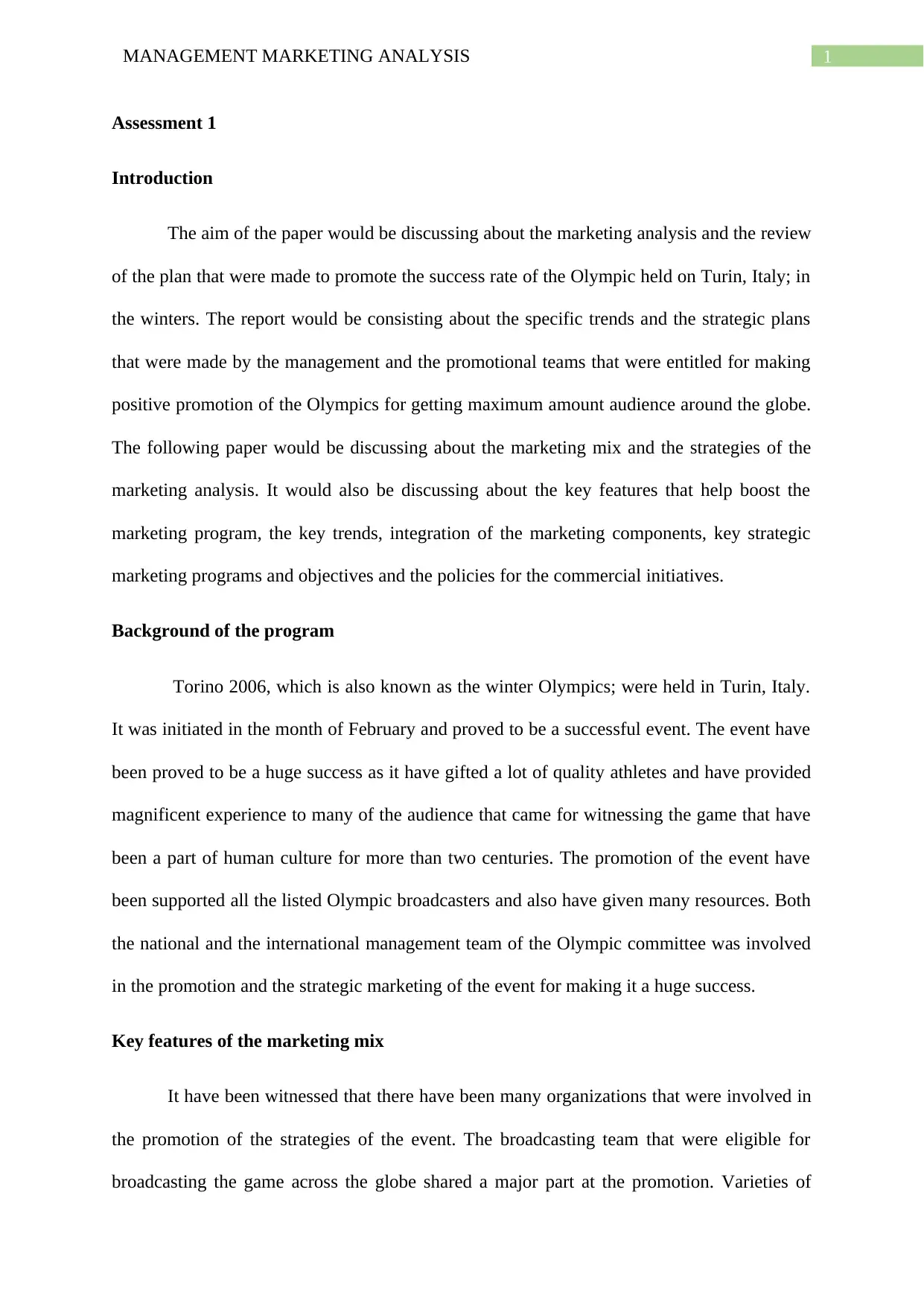
1MANAGEMENT MARKETING ANALYSIS
Assessment 1
Introduction
The aim of the paper would be discussing about the marketing analysis and the review
of the plan that were made to promote the success rate of the Olympic held on Turin, Italy; in
the winters. The report would be consisting about the specific trends and the strategic plans
that were made by the management and the promotional teams that were entitled for making
positive promotion of the Olympics for getting maximum amount audience around the globe.
The following paper would be discussing about the marketing mix and the strategies of the
marketing analysis. It would also be discussing about the key features that help boost the
marketing program, the key trends, integration of the marketing components, key strategic
marketing programs and objectives and the policies for the commercial initiatives.
Background of the program
Torino 2006, which is also known as the winter Olympics; were held in Turin, Italy.
It was initiated in the month of February and proved to be a successful event. The event have
been proved to be a huge success as it have gifted a lot of quality athletes and have provided
magnificent experience to many of the audience that came for witnessing the game that have
been a part of human culture for more than two centuries. The promotion of the event have
been supported all the listed Olympic broadcasters and also have given many resources. Both
the national and the international management team of the Olympic committee was involved
in the promotion and the strategic marketing of the event for making it a huge success.
Key features of the marketing mix
It have been witnessed that there have been many organizations that were involved in
the promotion of the strategies of the event. The broadcasting team that were eligible for
broadcasting the game across the globe shared a major part at the promotion. Varieties of
Assessment 1
Introduction
The aim of the paper would be discussing about the marketing analysis and the review
of the plan that were made to promote the success rate of the Olympic held on Turin, Italy; in
the winters. The report would be consisting about the specific trends and the strategic plans
that were made by the management and the promotional teams that were entitled for making
positive promotion of the Olympics for getting maximum amount audience around the globe.
The following paper would be discussing about the marketing mix and the strategies of the
marketing analysis. It would also be discussing about the key features that help boost the
marketing program, the key trends, integration of the marketing components, key strategic
marketing programs and objectives and the policies for the commercial initiatives.
Background of the program
Torino 2006, which is also known as the winter Olympics; were held in Turin, Italy.
It was initiated in the month of February and proved to be a successful event. The event have
been proved to be a huge success as it have gifted a lot of quality athletes and have provided
magnificent experience to many of the audience that came for witnessing the game that have
been a part of human culture for more than two centuries. The promotion of the event have
been supported all the listed Olympic broadcasters and also have given many resources. Both
the national and the international management team of the Olympic committee was involved
in the promotion and the strategic marketing of the event for making it a huge success.
Key features of the marketing mix
It have been witnessed that there have been many organizations that were involved in
the promotion of the strategies of the event. The broadcasting team that were eligible for
broadcasting the game across the globe shared a major part at the promotion. Varieties of
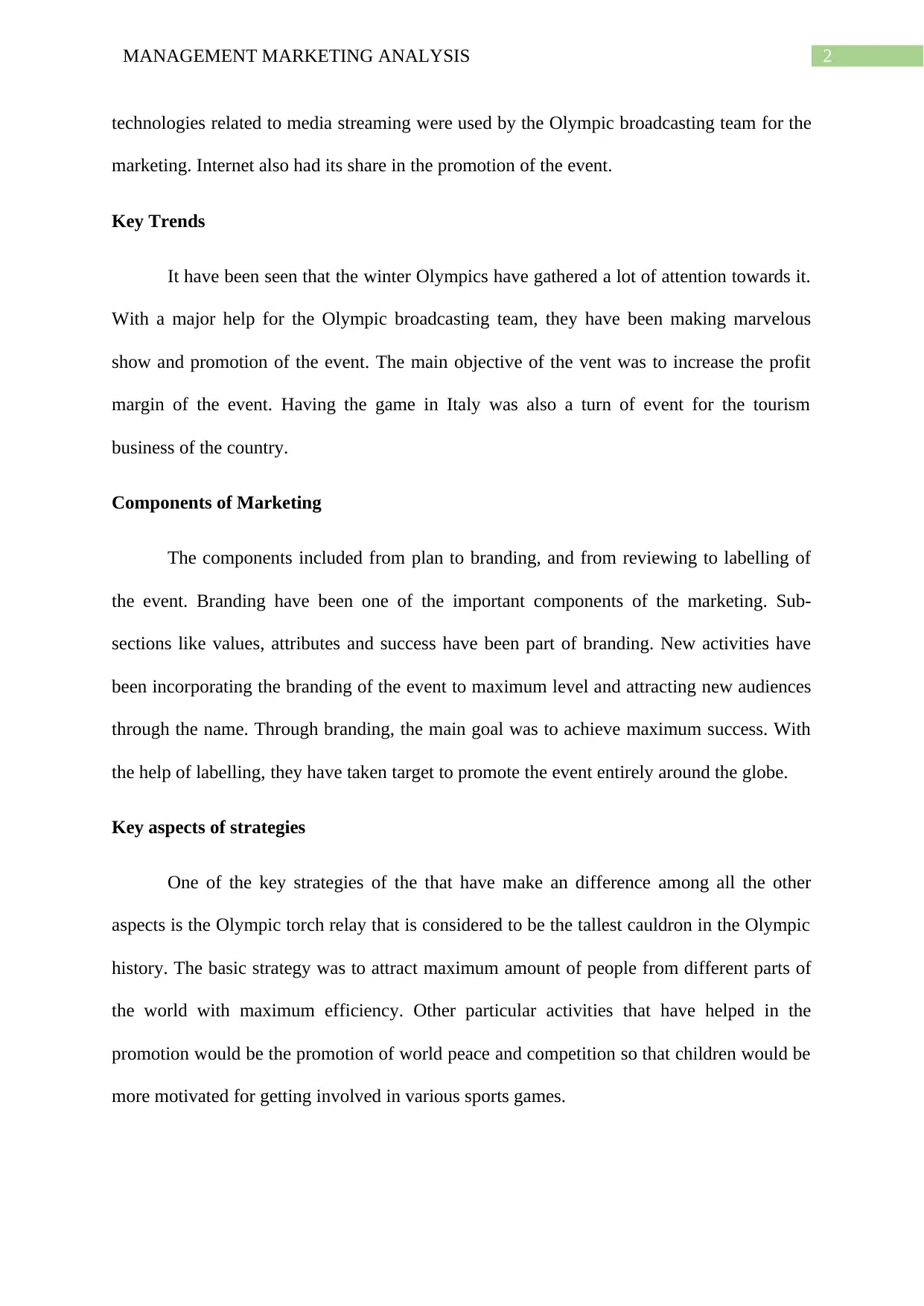
2MANAGEMENT MARKETING ANALYSIS
technologies related to media streaming were used by the Olympic broadcasting team for the
marketing. Internet also had its share in the promotion of the event.
Key Trends
It have been seen that the winter Olympics have gathered a lot of attention towards it.
With a major help for the Olympic broadcasting team, they have been making marvelous
show and promotion of the event. The main objective of the vent was to increase the profit
margin of the event. Having the game in Italy was also a turn of event for the tourism
business of the country.
Components of Marketing
The components included from plan to branding, and from reviewing to labelling of
the event. Branding have been one of the important components of the marketing. Sub-
sections like values, attributes and success have been part of branding. New activities have
been incorporating the branding of the event to maximum level and attracting new audiences
through the name. Through branding, the main goal was to achieve maximum success. With
the help of labelling, they have taken target to promote the event entirely around the globe.
Key aspects of strategies
One of the key strategies of the that have make an difference among all the other
aspects is the Olympic torch relay that is considered to be the tallest cauldron in the Olympic
history. The basic strategy was to attract maximum amount of people from different parts of
the world with maximum efficiency. Other particular activities that have helped in the
promotion would be the promotion of world peace and competition so that children would be
more motivated for getting involved in various sports games.
technologies related to media streaming were used by the Olympic broadcasting team for the
marketing. Internet also had its share in the promotion of the event.
Key Trends
It have been seen that the winter Olympics have gathered a lot of attention towards it.
With a major help for the Olympic broadcasting team, they have been making marvelous
show and promotion of the event. The main objective of the vent was to increase the profit
margin of the event. Having the game in Italy was also a turn of event for the tourism
business of the country.
Components of Marketing
The components included from plan to branding, and from reviewing to labelling of
the event. Branding have been one of the important components of the marketing. Sub-
sections like values, attributes and success have been part of branding. New activities have
been incorporating the branding of the event to maximum level and attracting new audiences
through the name. Through branding, the main goal was to achieve maximum success. With
the help of labelling, they have taken target to promote the event entirely around the globe.
Key aspects of strategies
One of the key strategies of the that have make an difference among all the other
aspects is the Olympic torch relay that is considered to be the tallest cauldron in the Olympic
history. The basic strategy was to attract maximum amount of people from different parts of
the world with maximum efficiency. Other particular activities that have helped in the
promotion would be the promotion of world peace and competition so that children would be
more motivated for getting involved in various sports games.
⊘ This is a preview!⊘
Do you want full access?
Subscribe today to unlock all pages.

Trusted by 1+ million students worldwide
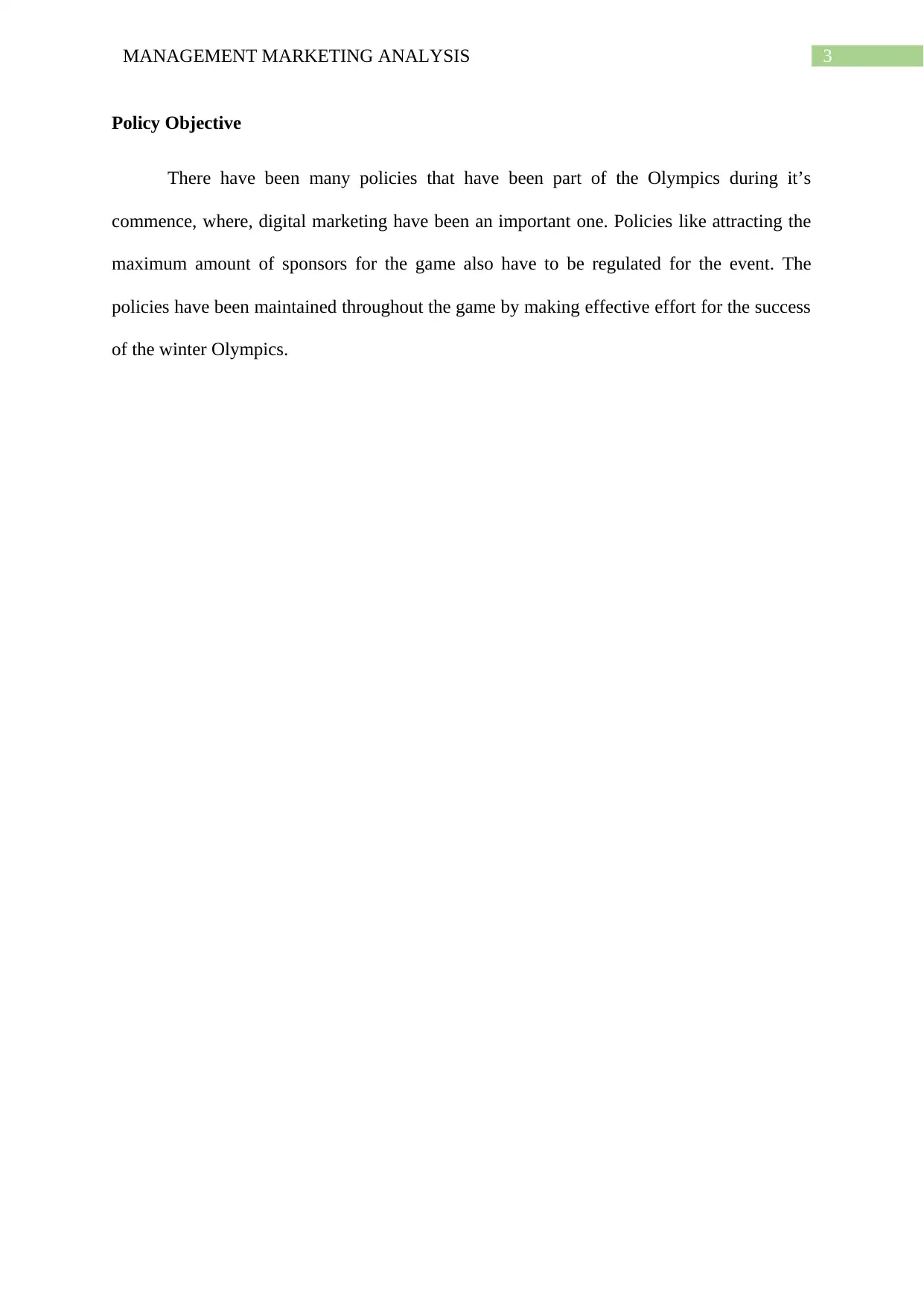
3MANAGEMENT MARKETING ANALYSIS
Policy Objective
There have been many policies that have been part of the Olympics during it’s
commence, where, digital marketing have been an important one. Policies like attracting the
maximum amount of sponsors for the game also have to be regulated for the event. The
policies have been maintained throughout the game by making effective effort for the success
of the winter Olympics.
Policy Objective
There have been many policies that have been part of the Olympics during it’s
commence, where, digital marketing have been an important one. Policies like attracting the
maximum amount of sponsors for the game also have to be regulated for the event. The
policies have been maintained throughout the game by making effective effort for the success
of the winter Olympics.
Paraphrase This Document
Need a fresh take? Get an instant paraphrase of this document with our AI Paraphraser
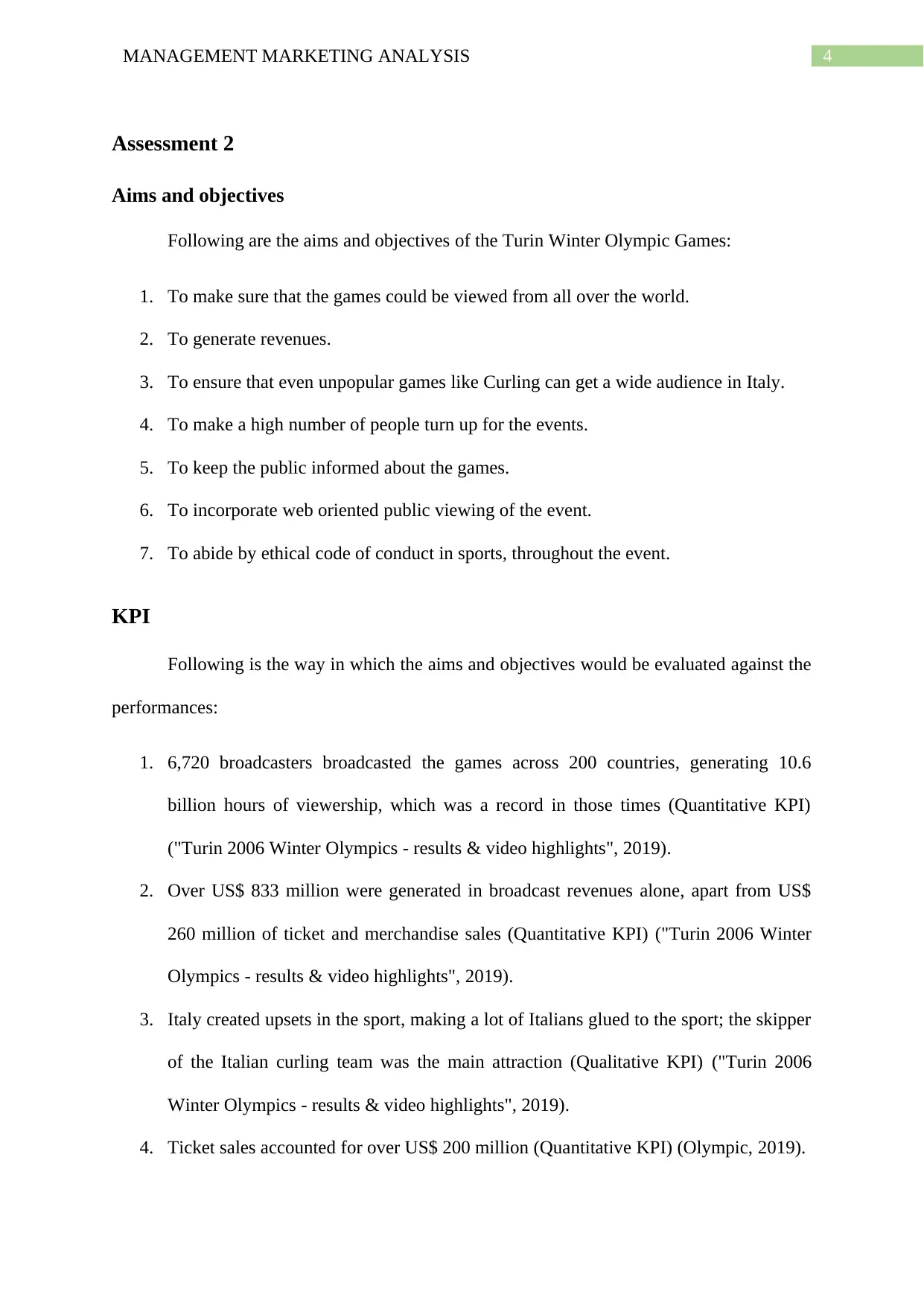
4MANAGEMENT MARKETING ANALYSIS
Assessment 2
Aims and objectives
Following are the aims and objectives of the Turin Winter Olympic Games:
1. To make sure that the games could be viewed from all over the world.
2. To generate revenues.
3. To ensure that even unpopular games like Curling can get a wide audience in Italy.
4. To make a high number of people turn up for the events.
5. To keep the public informed about the games.
6. To incorporate web oriented public viewing of the event.
7. To abide by ethical code of conduct in sports, throughout the event.
KPI
Following is the way in which the aims and objectives would be evaluated against the
performances:
1. 6,720 broadcasters broadcasted the games across 200 countries, generating 10.6
billion hours of viewership, which was a record in those times (Quantitative KPI)
("Turin 2006 Winter Olympics - results & video highlights", 2019).
2. Over US$ 833 million were generated in broadcast revenues alone, apart from US$
260 million of ticket and merchandise sales (Quantitative KPI) ("Turin 2006 Winter
Olympics - results & video highlights", 2019).
3. Italy created upsets in the sport, making a lot of Italians glued to the sport; the skipper
of the Italian curling team was the main attraction (Qualitative KPI) ("Turin 2006
Winter Olympics - results & video highlights", 2019).
4. Ticket sales accounted for over US$ 200 million (Quantitative KPI) (Olympic, 2019).
Assessment 2
Aims and objectives
Following are the aims and objectives of the Turin Winter Olympic Games:
1. To make sure that the games could be viewed from all over the world.
2. To generate revenues.
3. To ensure that even unpopular games like Curling can get a wide audience in Italy.
4. To make a high number of people turn up for the events.
5. To keep the public informed about the games.
6. To incorporate web oriented public viewing of the event.
7. To abide by ethical code of conduct in sports, throughout the event.
KPI
Following is the way in which the aims and objectives would be evaluated against the
performances:
1. 6,720 broadcasters broadcasted the games across 200 countries, generating 10.6
billion hours of viewership, which was a record in those times (Quantitative KPI)
("Turin 2006 Winter Olympics - results & video highlights", 2019).
2. Over US$ 833 million were generated in broadcast revenues alone, apart from US$
260 million of ticket and merchandise sales (Quantitative KPI) ("Turin 2006 Winter
Olympics - results & video highlights", 2019).
3. Italy created upsets in the sport, making a lot of Italians glued to the sport; the skipper
of the Italian curling team was the main attraction (Qualitative KPI) ("Turin 2006
Winter Olympics - results & video highlights", 2019).
4. Ticket sales accounted for over US$ 200 million (Quantitative KPI) (Olympic, 2019).

5MANAGEMENT MARKETING ANALYSIS
5. 700 million page views on the exclusive page of the Turin winter games, with over
2,688 written press associates all over the world (Quantitative KPI) ("Turin 2006
Winter Olympics - results & video highlights", 2019).
6. 700 million page views on the exclusive page of the Turin winter games (Quantitative
KPI) ("Turin 2006 Winter Olympics - results & video highlights", 2019).
7. A record 1,219 anti doping tests were administered (Leading KPI) ("Turin 2006
Winter Olympics - results & video highlights", 2019).
Key stakeholders
Following were the key stakeholders for the event:
International Olympics committee.
CNN international (Olympic, 2019)
ESPN international (Olympic, 2019)
BGBNT (Olympic, 2019)
TRT (Olympic, 2019)
YLE (Olympic, 2019)
ARD TV (Olympic, 2019)
Audiences
Stadium committees
Government
Athletes
Communication strategy
The main strategy of the winter Olympics of 2006 was to reach out to the worldwide
audience through a varied range of broadcast partners and the internet. The idea was to create
an essence of sportsmanship for the games, with the feelings of trust, respect and excellence.
5. 700 million page views on the exclusive page of the Turin winter games, with over
2,688 written press associates all over the world (Quantitative KPI) ("Turin 2006
Winter Olympics - results & video highlights", 2019).
6. 700 million page views on the exclusive page of the Turin winter games (Quantitative
KPI) ("Turin 2006 Winter Olympics - results & video highlights", 2019).
7. A record 1,219 anti doping tests were administered (Leading KPI) ("Turin 2006
Winter Olympics - results & video highlights", 2019).
Key stakeholders
Following were the key stakeholders for the event:
International Olympics committee.
CNN international (Olympic, 2019)
ESPN international (Olympic, 2019)
BGBNT (Olympic, 2019)
TRT (Olympic, 2019)
YLE (Olympic, 2019)
ARD TV (Olympic, 2019)
Audiences
Stadium committees
Government
Athletes
Communication strategy
The main strategy of the winter Olympics of 2006 was to reach out to the worldwide
audience through a varied range of broadcast partners and the internet. The idea was to create
an essence of sportsmanship for the games, with the feelings of trust, respect and excellence.
⊘ This is a preview!⊘
Do you want full access?
Subscribe today to unlock all pages.

Trusted by 1+ million students worldwide
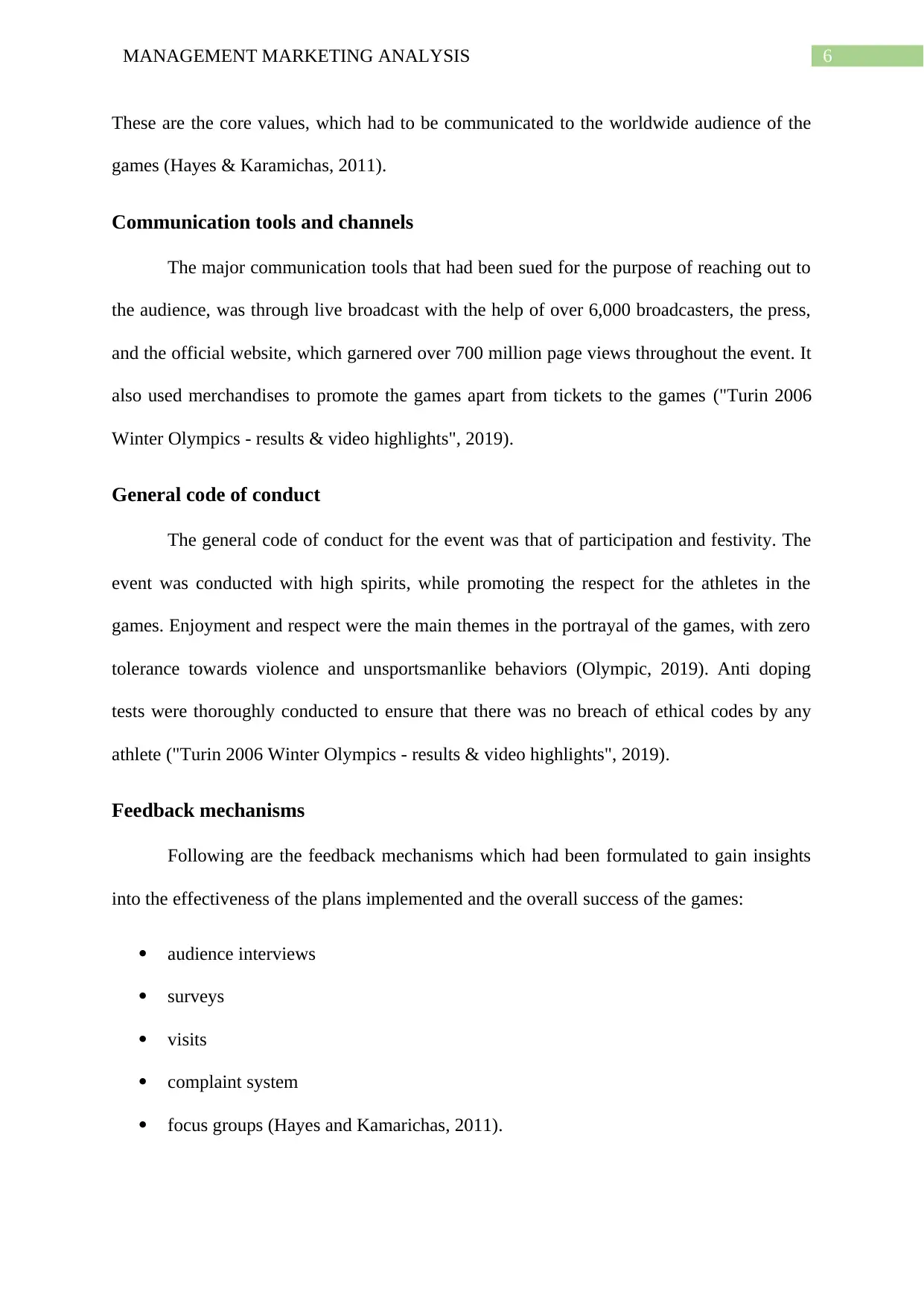
6MANAGEMENT MARKETING ANALYSIS
These are the core values, which had to be communicated to the worldwide audience of the
games (Hayes & Karamichas, 2011).
Communication tools and channels
The major communication tools that had been sued for the purpose of reaching out to
the audience, was through live broadcast with the help of over 6,000 broadcasters, the press,
and the official website, which garnered over 700 million page views throughout the event. It
also used merchandises to promote the games apart from tickets to the games ("Turin 2006
Winter Olympics - results & video highlights", 2019).
General code of conduct
The general code of conduct for the event was that of participation and festivity. The
event was conducted with high spirits, while promoting the respect for the athletes in the
games. Enjoyment and respect were the main themes in the portrayal of the games, with zero
tolerance towards violence and unsportsmanlike behaviors (Olympic, 2019). Anti doping
tests were thoroughly conducted to ensure that there was no breach of ethical codes by any
athlete ("Turin 2006 Winter Olympics - results & video highlights", 2019).
Feedback mechanisms
Following are the feedback mechanisms which had been formulated to gain insights
into the effectiveness of the plans implemented and the overall success of the games:
audience interviews
surveys
visits
complaint system
focus groups (Hayes and Kamarichas, 2011).
These are the core values, which had to be communicated to the worldwide audience of the
games (Hayes & Karamichas, 2011).
Communication tools and channels
The major communication tools that had been sued for the purpose of reaching out to
the audience, was through live broadcast with the help of over 6,000 broadcasters, the press,
and the official website, which garnered over 700 million page views throughout the event. It
also used merchandises to promote the games apart from tickets to the games ("Turin 2006
Winter Olympics - results & video highlights", 2019).
General code of conduct
The general code of conduct for the event was that of participation and festivity. The
event was conducted with high spirits, while promoting the respect for the athletes in the
games. Enjoyment and respect were the main themes in the portrayal of the games, with zero
tolerance towards violence and unsportsmanlike behaviors (Olympic, 2019). Anti doping
tests were thoroughly conducted to ensure that there was no breach of ethical codes by any
athlete ("Turin 2006 Winter Olympics - results & video highlights", 2019).
Feedback mechanisms
Following are the feedback mechanisms which had been formulated to gain insights
into the effectiveness of the plans implemented and the overall success of the games:
audience interviews
surveys
visits
complaint system
focus groups (Hayes and Kamarichas, 2011).
Paraphrase This Document
Need a fresh take? Get an instant paraphrase of this document with our AI Paraphraser
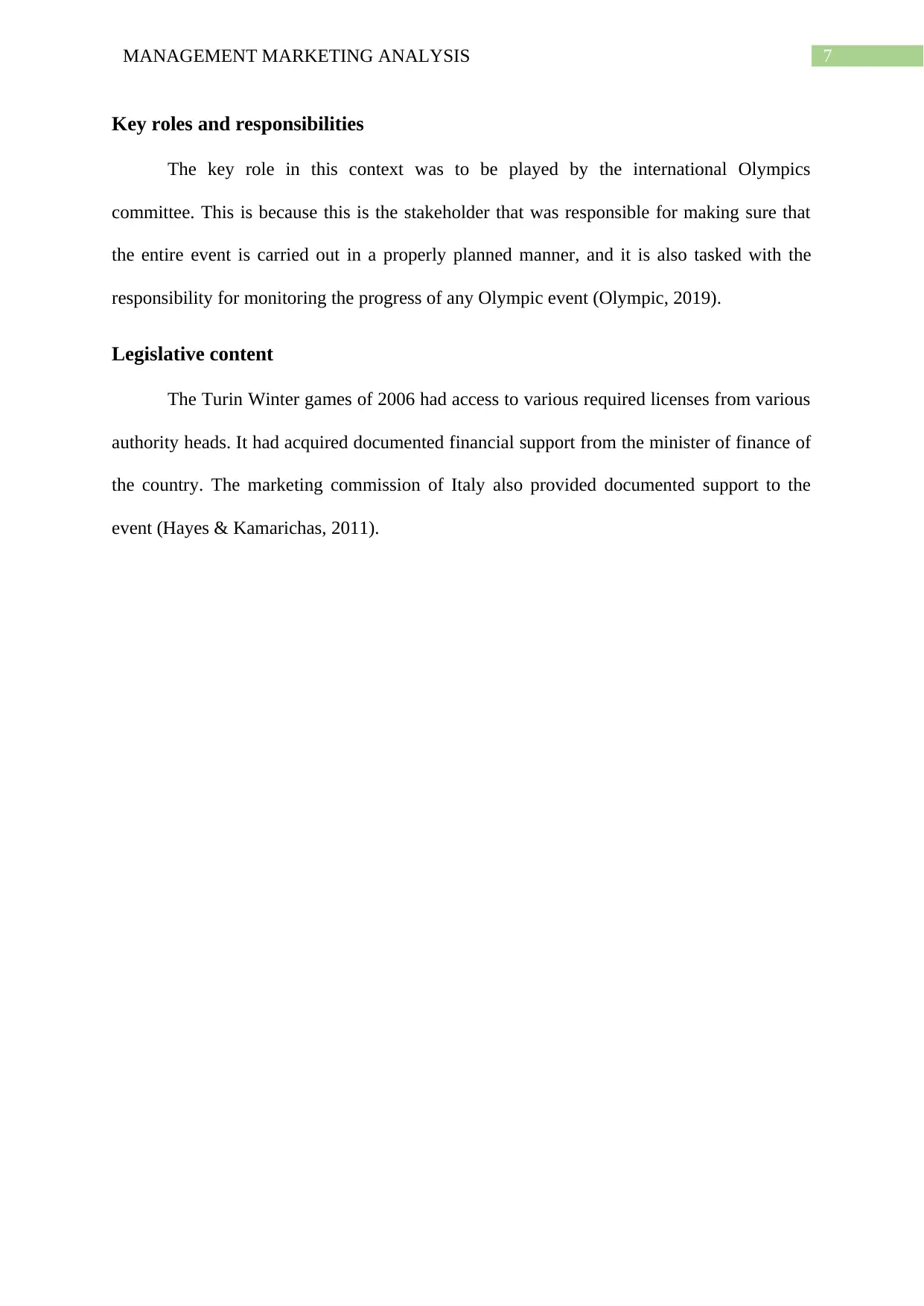
7MANAGEMENT MARKETING ANALYSIS
Key roles and responsibilities
The key role in this context was to be played by the international Olympics
committee. This is because this is the stakeholder that was responsible for making sure that
the entire event is carried out in a properly planned manner, and it is also tasked with the
responsibility for monitoring the progress of any Olympic event (Olympic, 2019).
Legislative content
The Turin Winter games of 2006 had access to various required licenses from various
authority heads. It had acquired documented financial support from the minister of finance of
the country. The marketing commission of Italy also provided documented support to the
event (Hayes & Kamarichas, 2011).
Key roles and responsibilities
The key role in this context was to be played by the international Olympics
committee. This is because this is the stakeholder that was responsible for making sure that
the entire event is carried out in a properly planned manner, and it is also tasked with the
responsibility for monitoring the progress of any Olympic event (Olympic, 2019).
Legislative content
The Turin Winter games of 2006 had access to various required licenses from various
authority heads. It had acquired documented financial support from the minister of finance of
the country. The marketing commission of Italy also provided documented support to the
event (Hayes & Kamarichas, 2011).
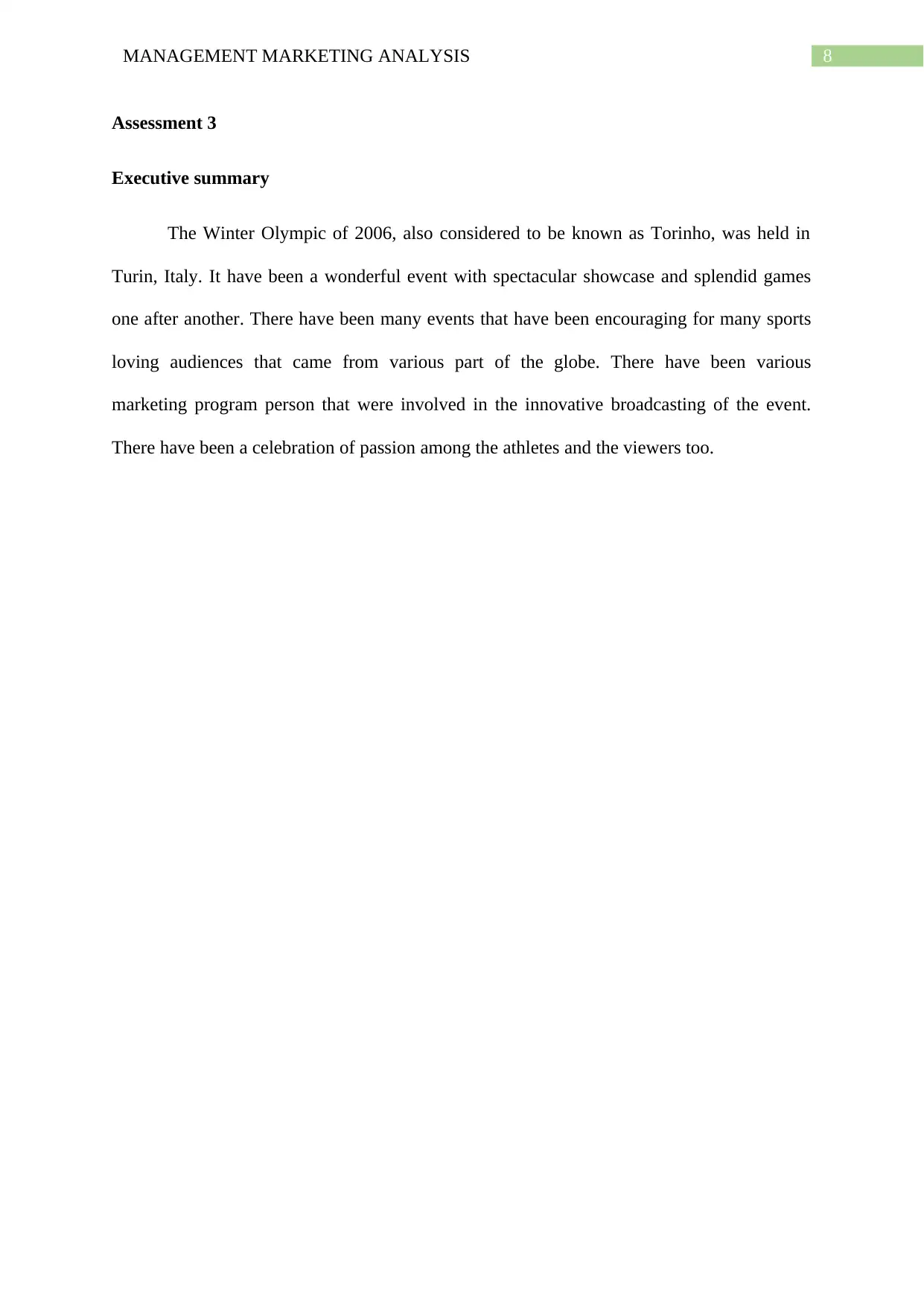
8MANAGEMENT MARKETING ANALYSIS
Assessment 3
Executive summary
The Winter Olympic of 2006, also considered to be known as Torinho, was held in
Turin, Italy. It have been a wonderful event with spectacular showcase and splendid games
one after another. There have been many events that have been encouraging for many sports
loving audiences that came from various part of the globe. There have been various
marketing program person that were involved in the innovative broadcasting of the event.
There have been a celebration of passion among the athletes and the viewers too.
Assessment 3
Executive summary
The Winter Olympic of 2006, also considered to be known as Torinho, was held in
Turin, Italy. It have been a wonderful event with spectacular showcase and splendid games
one after another. There have been many events that have been encouraging for many sports
loving audiences that came from various part of the globe. There have been various
marketing program person that were involved in the innovative broadcasting of the event.
There have been a celebration of passion among the athletes and the viewers too.
⊘ This is a preview!⊘
Do you want full access?
Subscribe today to unlock all pages.

Trusted by 1+ million students worldwide
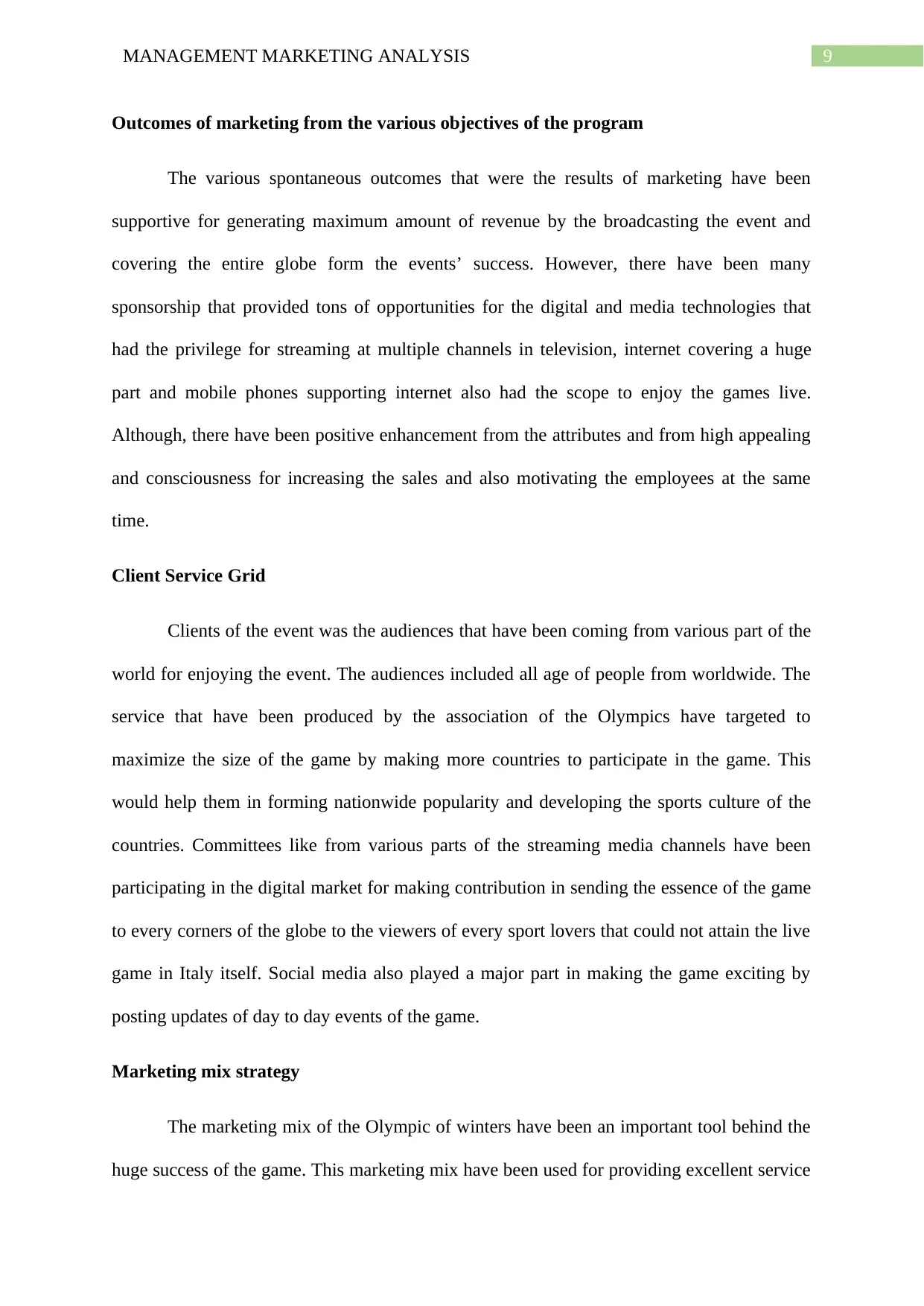
9MANAGEMENT MARKETING ANALYSIS
Outcomes of marketing from the various objectives of the program
The various spontaneous outcomes that were the results of marketing have been
supportive for generating maximum amount of revenue by the broadcasting the event and
covering the entire globe form the events’ success. However, there have been many
sponsorship that provided tons of opportunities for the digital and media technologies that
had the privilege for streaming at multiple channels in television, internet covering a huge
part and mobile phones supporting internet also had the scope to enjoy the games live.
Although, there have been positive enhancement from the attributes and from high appealing
and consciousness for increasing the sales and also motivating the employees at the same
time.
Client Service Grid
Clients of the event was the audiences that have been coming from various part of the
world for enjoying the event. The audiences included all age of people from worldwide. The
service that have been produced by the association of the Olympics have targeted to
maximize the size of the game by making more countries to participate in the game. This
would help them in forming nationwide popularity and developing the sports culture of the
countries. Committees like from various parts of the streaming media channels have been
participating in the digital market for making contribution in sending the essence of the game
to every corners of the globe to the viewers of every sport lovers that could not attain the live
game in Italy itself. Social media also played a major part in making the game exciting by
posting updates of day to day events of the game.
Marketing mix strategy
The marketing mix of the Olympic of winters have been an important tool behind the
huge success of the game. This marketing mix have been used for providing excellent service
Outcomes of marketing from the various objectives of the program
The various spontaneous outcomes that were the results of marketing have been
supportive for generating maximum amount of revenue by the broadcasting the event and
covering the entire globe form the events’ success. However, there have been many
sponsorship that provided tons of opportunities for the digital and media technologies that
had the privilege for streaming at multiple channels in television, internet covering a huge
part and mobile phones supporting internet also had the scope to enjoy the games live.
Although, there have been positive enhancement from the attributes and from high appealing
and consciousness for increasing the sales and also motivating the employees at the same
time.
Client Service Grid
Clients of the event was the audiences that have been coming from various part of the
world for enjoying the event. The audiences included all age of people from worldwide. The
service that have been produced by the association of the Olympics have targeted to
maximize the size of the game by making more countries to participate in the game. This
would help them in forming nationwide popularity and developing the sports culture of the
countries. Committees like from various parts of the streaming media channels have been
participating in the digital market for making contribution in sending the essence of the game
to every corners of the globe to the viewers of every sport lovers that could not attain the live
game in Italy itself. Social media also played a major part in making the game exciting by
posting updates of day to day events of the game.
Marketing mix strategy
The marketing mix of the Olympic of winters have been an important tool behind the
huge success of the game. This marketing mix have been used for providing excellent service
Paraphrase This Document
Need a fresh take? Get an instant paraphrase of this document with our AI Paraphraser
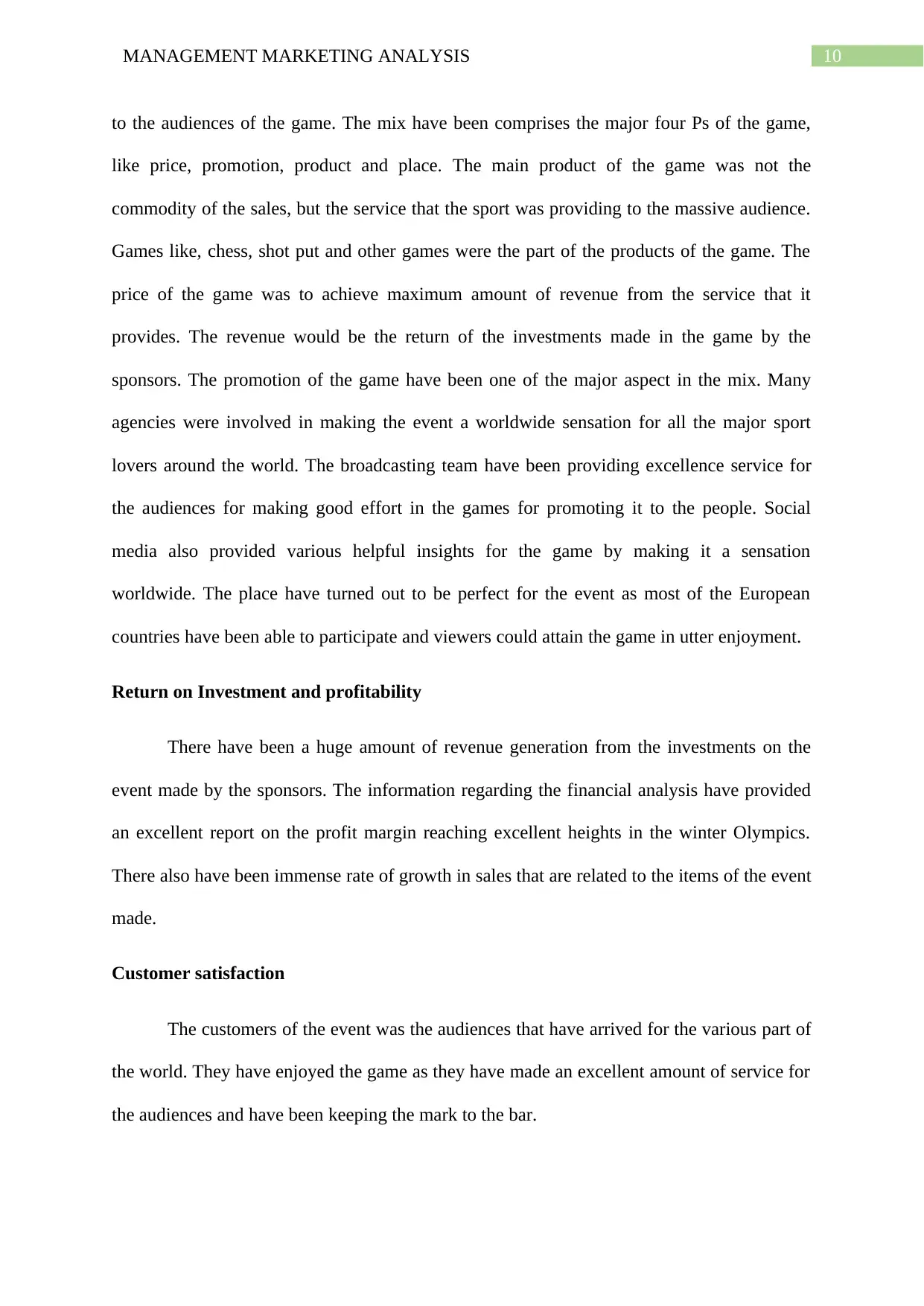
10MANAGEMENT MARKETING ANALYSIS
to the audiences of the game. The mix have been comprises the major four Ps of the game,
like price, promotion, product and place. The main product of the game was not the
commodity of the sales, but the service that the sport was providing to the massive audience.
Games like, chess, shot put and other games were the part of the products of the game. The
price of the game was to achieve maximum amount of revenue from the service that it
provides. The revenue would be the return of the investments made in the game by the
sponsors. The promotion of the game have been one of the major aspect in the mix. Many
agencies were involved in making the event a worldwide sensation for all the major sport
lovers around the world. The broadcasting team have been providing excellence service for
the audiences for making good effort in the games for promoting it to the people. Social
media also provided various helpful insights for the game by making it a sensation
worldwide. The place have turned out to be perfect for the event as most of the European
countries have been able to participate and viewers could attain the game in utter enjoyment.
Return on Investment and profitability
There have been a huge amount of revenue generation from the investments on the
event made by the sponsors. The information regarding the financial analysis have provided
an excellent report on the profit margin reaching excellent heights in the winter Olympics.
There also have been immense rate of growth in sales that are related to the items of the event
made.
Customer satisfaction
The customers of the event was the audiences that have arrived for the various part of
the world. They have enjoyed the game as they have made an excellent amount of service for
the audiences and have been keeping the mark to the bar.
to the audiences of the game. The mix have been comprises the major four Ps of the game,
like price, promotion, product and place. The main product of the game was not the
commodity of the sales, but the service that the sport was providing to the massive audience.
Games like, chess, shot put and other games were the part of the products of the game. The
price of the game was to achieve maximum amount of revenue from the service that it
provides. The revenue would be the return of the investments made in the game by the
sponsors. The promotion of the game have been one of the major aspect in the mix. Many
agencies were involved in making the event a worldwide sensation for all the major sport
lovers around the world. The broadcasting team have been providing excellence service for
the audiences for making good effort in the games for promoting it to the people. Social
media also provided various helpful insights for the game by making it a sensation
worldwide. The place have turned out to be perfect for the event as most of the European
countries have been able to participate and viewers could attain the game in utter enjoyment.
Return on Investment and profitability
There have been a huge amount of revenue generation from the investments on the
event made by the sponsors. The information regarding the financial analysis have provided
an excellent report on the profit margin reaching excellent heights in the winter Olympics.
There also have been immense rate of growth in sales that are related to the items of the event
made.
Customer satisfaction
The customers of the event was the audiences that have arrived for the various part of
the world. They have enjoyed the game as they have made an excellent amount of service for
the audiences and have been keeping the mark to the bar.
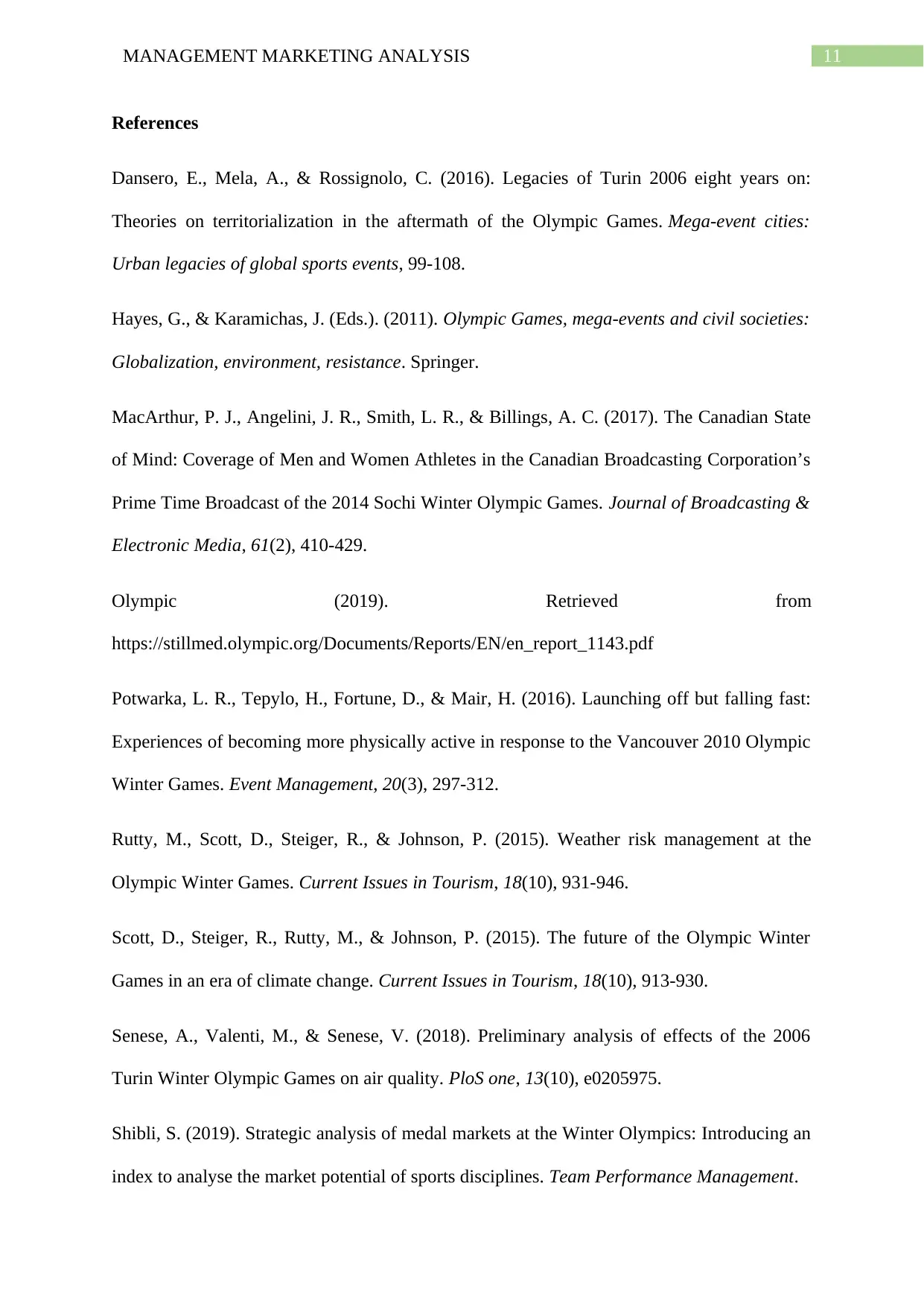
11MANAGEMENT MARKETING ANALYSIS
References
Dansero, E., Mela, A., & Rossignolo, C. (2016). Legacies of Turin 2006 eight years on:
Theories on territorialization in the aftermath of the Olympic Games. Mega-event cities:
Urban legacies of global sports events, 99-108.
Hayes, G., & Karamichas, J. (Eds.). (2011). Olympic Games, mega-events and civil societies:
Globalization, environment, resistance. Springer.
MacArthur, P. J., Angelini, J. R., Smith, L. R., & Billings, A. C. (2017). The Canadian State
of Mind: Coverage of Men and Women Athletes in the Canadian Broadcasting Corporation’s
Prime Time Broadcast of the 2014 Sochi Winter Olympic Games. Journal of Broadcasting &
Electronic Media, 61(2), 410-429.
Olympic (2019). Retrieved from
https://stillmed.olympic.org/Documents/Reports/EN/en_report_1143.pdf
Potwarka, L. R., Tepylo, H., Fortune, D., & Mair, H. (2016). Launching off but falling fast:
Experiences of becoming more physically active in response to the Vancouver 2010 Olympic
Winter Games. Event Management, 20(3), 297-312.
Rutty, M., Scott, D., Steiger, R., & Johnson, P. (2015). Weather risk management at the
Olympic Winter Games. Current Issues in Tourism, 18(10), 931-946.
Scott, D., Steiger, R., Rutty, M., & Johnson, P. (2015). The future of the Olympic Winter
Games in an era of climate change. Current Issues in Tourism, 18(10), 913-930.
Senese, A., Valenti, M., & Senese, V. (2018). Preliminary analysis of effects of the 2006
Turin Winter Olympic Games on air quality. PloS one, 13(10), e0205975.
Shibli, S. (2019). Strategic analysis of medal markets at the Winter Olympics: Introducing an
index to analyse the market potential of sports disciplines. Team Performance Management.
References
Dansero, E., Mela, A., & Rossignolo, C. (2016). Legacies of Turin 2006 eight years on:
Theories on territorialization in the aftermath of the Olympic Games. Mega-event cities:
Urban legacies of global sports events, 99-108.
Hayes, G., & Karamichas, J. (Eds.). (2011). Olympic Games, mega-events and civil societies:
Globalization, environment, resistance. Springer.
MacArthur, P. J., Angelini, J. R., Smith, L. R., & Billings, A. C. (2017). The Canadian State
of Mind: Coverage of Men and Women Athletes in the Canadian Broadcasting Corporation’s
Prime Time Broadcast of the 2014 Sochi Winter Olympic Games. Journal of Broadcasting &
Electronic Media, 61(2), 410-429.
Olympic (2019). Retrieved from
https://stillmed.olympic.org/Documents/Reports/EN/en_report_1143.pdf
Potwarka, L. R., Tepylo, H., Fortune, D., & Mair, H. (2016). Launching off but falling fast:
Experiences of becoming more physically active in response to the Vancouver 2010 Olympic
Winter Games. Event Management, 20(3), 297-312.
Rutty, M., Scott, D., Steiger, R., & Johnson, P. (2015). Weather risk management at the
Olympic Winter Games. Current Issues in Tourism, 18(10), 931-946.
Scott, D., Steiger, R., Rutty, M., & Johnson, P. (2015). The future of the Olympic Winter
Games in an era of climate change. Current Issues in Tourism, 18(10), 913-930.
Senese, A., Valenti, M., & Senese, V. (2018). Preliminary analysis of effects of the 2006
Turin Winter Olympic Games on air quality. PloS one, 13(10), e0205975.
Shibli, S. (2019). Strategic analysis of medal markets at the Winter Olympics: Introducing an
index to analyse the market potential of sports disciplines. Team Performance Management.
⊘ This is a preview!⊘
Do you want full access?
Subscribe today to unlock all pages.

Trusted by 1+ million students worldwide
1 out of 13
Related Documents
Your All-in-One AI-Powered Toolkit for Academic Success.
+13062052269
info@desklib.com
Available 24*7 on WhatsApp / Email
![[object Object]](/_next/static/media/star-bottom.7253800d.svg)
Unlock your academic potential
Copyright © 2020–2025 A2Z Services. All Rights Reserved. Developed and managed by ZUCOL.





